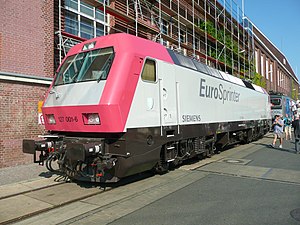Siemens ES64P
| Siemens UR-EuroSprinter | |
|---|---|
|
127 001 in the AW Dessau
|
|
| Numbering: | ES 64 P 001 127 001 ES01 |
| Number: | 1 |
| Manufacturer: | Siemens Transportation Systems , Krauss-Maffei |
| Year of construction (s): | 1992 |
| Axis formula : | Bo'Bo ' |
| Gauge : | 1435 mm ( standard gauge ) |
| Length over buffers: | 19.28 m |
| Service mass: | 86 t |
| Wheel set mass : | 21.5 t |
| Top speed: | 230 km / h |
| Continuous output : | 6400 kW / 7200 kW |
| Starting tractive effort: | 300 kN |
| Power system : | 15 kV, 16⅔ Hz |
| Power transmission: | Overhead line |
| Number of traction motors: | 4th |
| Drive: | Rubber joint hollow shaft drive |
| Brake: | Knorr-Bremse with unitary effect KE-GPR mZ EP, internally ventilated disc brakes |
| Train control : | PZB , LZB |
The Siemens ES64P is a locomotive for heavy goods train traffic as well as for fast passenger traffic. It is the prototype of the Siemens ES64 EuroSprinter family and was used as a test vehicle for new components and environmentally friendly materials at Deutsche Bahn as 127 001 .
history
The prototype 127 001 was produced to test modern three-phase AC technology in electric locomotives and can therefore be described as the “original mother” of the current Siemens three-phase locomotives. With a speed of 310 km / h, the 127 001 set a new world record for three-phase locomotives on August 6, 1993 on the high-speed line Hanover – Würzburg between Würzburg and Fulda .
After the end of the test runs, the locomotive was used to demonstrate its performance in demonstration runs in other European countries, including Norway , Sweden and Switzerland , and then used in front of Deutsche Bahn passenger trains. In 2002 it was integrated into the Dispolok pool, which was accompanied by a change in the color of the driver's cabs from red to the usual Dispolok yellow. The locomotive has been listed in the Wegberg-Wildenrath test center as PCW 8 since 2009 . It is mainly used for transfer journeys of locomotives and railcars intended for foreign operators that are not designed or not approved for the German 15 kV system.
Use abroad
Numerous variants that operate in other European countries were derived from 127 001:
Greece
The Greek Organismos Sidirodromon Ellados (OSE) has 30 locomotives of this type as class 120 and the only Greek electric locomotive type in service. The machines are largely identical to the 127 001, but for 25 kV with 50 Hz AC voltage, and they only have an output of 5000 kW.
The first six copies were ordered as early as 1996 and listed as I. 561 to I. 566 delivered. In 1997 a further 24 locomotives, now designated as 120 007 to 030 , were ordered. These were only delivered between 2000 and 2002 after some delays. The machines that arrived in Greece could hardly be used for years because the expansion of electrification was slow and because the volume of traffic on the first electrified line from Thessaloníki to Idomeni and further towards Macedonia due to the political differences between Greece and Macedonia caused by Greek embargo measures around the The turn of the millennium had reached a low point. Some machines had neither received UIC EDP numbers nor revision addresses in 2016; the ones that were not in use were parked in the Thessaloniki depot with the paintwork that has meanwhile been weathered.
Spain and Portugal
The series 252 of the Spanish Red Nacional de los Ferrocarriles Españoles (RENFE) and 5600 of the Portuguese Comboios de Portugal (CP) were derived from the German 120.1 series . The first 15 locomotives for RENFE were ordered as early as 1989 and delivered in the regular gauge in 1991, i.e. before the actual prototype was built. This was in 1992 with a few changes as the 16th copy after the construction of the 252 for Spain with one to 6400 kW increased power. The series locomotives are a little longer than this prototype (20th century) because of the dual system capability required 380 millimeters) and have air-conditioned driver's cabs, their output is 5600 kW. You can under 3 kV equal and 25 kV AC voltage can be used. The Spanish manufacturers CAF and GATSA built another 15 and 45 copies under license, but for Iberian broad gauge and partly without AC voltage equipment . The machines designed for both voltages were re-gauged at RENFE, if necessary, to standard or broad gauge, most recently this concerned machines for the standard-gauge freight train service between Barcelona and France. For these services, the affected machines also had to operate at 1.5 be made suitable for kV.
The 30 Portuguese locomotives are largely identical to the Spanish ones and also have wide gauge, but they are only for operation with 25 kV AC voltage. They were built under license by the Portuguese manufacturer Sorefame .








